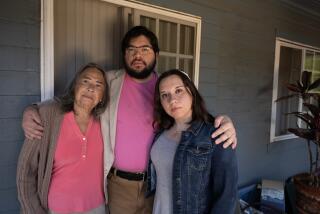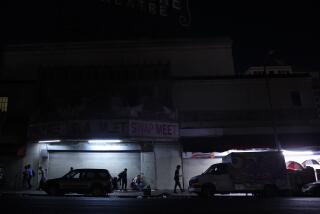Residents Reclaiming Their Street : Crime: Santa Ana neighbors have united with landlords, city officials and police to drive out gang members.
SANTA ANA â With its palm-dotted sidewalks and homes trimmed with begonias and impatiens, North Spurgeon Street hardly looks like a dangerous place. Only three months ago residents were afraid to stand near their windows or walk to the store because gang members controlled the street.
Residents have banded together to roll back years of public nuisances and crime by ousting local gangs.
âI have sat and just watched people discharge their guns and seen the flames come out of the gun,â said Ed McKie, 37, the catalyst behind the residentsâ efforts to clean up their street. âIt got to the point where I was calling the police every time I heard a gunshot, which meant, oh, five or six times a week.â
For years, the effort to turn the neighborhood around centered on calling the police after each problem occurred. The police would respond, but there was little they could do if the incident had already ended.
âI called the police so many times they knew who it was every time the phone rang,â said North Spurgeon Street resident Edith Shreeves.
But nothing really worked until residents began using the Safe Streets Now! program in February.
The city program brings together residents, city officials, police and landlords when a property has become a public nuisance or center for crime. Landlords allow police onto their property while neighbors keep an eye out for trouble, documenting problems and alerting authorities.
âItâs just one of the tools we use to empower the community, to give them methods to solve problems without having police involvement all the time,â Police Lt. David Nick said.
McKie rallied the streetâs residents to keep logs of public nuisances and crimes they observed and to work with police to turn the neighborhood around.
Particularly at issue was an apartment complex in the 1400 block where visiting gang members intimidated residents, stole car stereos and acted as a magnet for shootings, drug deals and other crime, neighbors said.
âItâs like this whole street was their supermarket,â McKie said.
Many residents were living in fear.
To get to a nearby convenience store, real estate agent Patrick Eldridge, 33, used to drive around the block rather than walk by loitering gang members.
âI wasnât so much afraid that they would do something to me as just maybe being in the wrong place and getting caught in the cross-fire,â Eldridge said.
The residentsâ biggest ally turned out to be Michael Murphy of Huntington Beach, the apartment complexâs owner.
McKie wrote to Murphy on March 6, telling him that unless he took action to keep the gang members away from his property, 22 area neighbors had agreed to sue him in small-claims court on May 6.
Neighbors said they expected a court fight, but Murphy surprised them by responding in two days, agreeing to meet with residents and officials. Soon he had trimmed hedges at the property, installed more lights and had given police the authority to arrest non-resident loiterers--something he wasnât aware they needed his permission to do.
âI knew there was a problem there but I was kind of lost at to what to do about it,â Murphy said. âI called the police a few times to get help, but that didnât solve the gang problem.â
Since Murphy hung âNo Trespassingâ signs and gave police written permission to focus on his property, 12 arrests have been made in 10 weeks at the complex. The arrestees, ages 14 to 24, face charges that include trespassing and possession of drugs with intent to sell.
âI think [Safe Streets Now!] is a great program,â Murphy said. âItâs rough on some people at first, but in the long run it helps the streets and your property values go back up, hopefully.â
Even some residents living in the apartment building where gang members would congregate say they too were fed up with the loitering and drug dealing.
âNow . . . the police come every night,â said Hector Curio, 28. âAnd I think itâs a good idea for them to come here a lot. Those gang members broke my window and took the vacuum.â
Murphy recently gave the buildingâs residents cause for optimism. He sent 30-day eviction notices to tenants in two apartments whom police identified as the draw for gang members. Because the tenants have until monthâs end to leave, no one is claiming a complete victory until they have moved out.
The next step will be to increase communication among landlords so that troublesome tenants who have been evicted from one complex do not simply move to another in the neighborhood.
Longtime community activist Jim Walker, one of those who first met with Murphy, said the North Spurgeon Street programâs success has been unique. In particular, he said, the residentsâ high level of commitment and Murphyâs instant cooperation are unusual.
âInstead of getting defensive, he joined us and listened to peopleâs concerns,â Walker said. âThat is exactly how neighborhood organizing is supposed to work, and it almost never does.â
Next month, using a portion of a $1.4 million-grant from the 1994 federal crime bill, the police plan to increase their presence in the square-mile neighborhood that includes French Court from eight to 15 officers. The area was chosen for increased attention because its residents make the most calls to police for help, and because of its active neighborhood groups.
âBecause of the strong neighborhood associations there, we felt we could go in the community and effect some long-term change,â Nick said.
Although the area has a lot of crime, Nick said, it would be unfair to take crime statistics for the entire area and apply them to North Spurgeon Street.
Overhauling the character of the neighborhood will take some time, residents said, but they are committed having a safe street.
âIâve lived here almost 15 years and I have an investment here,â said Eleonore Johnson, 61. âIâm not going to run from neighborhood to neighborhood. Everyone has to get involved and take responsibility for their neighborhoods--thatâs the only way.â
McKie said there is no escaping urban problems.
âItâs not the 1950s when, if you lived in the big city, you could move to the country and be safe,â he said. âNow, whether you live in Anaheim or Garden Grove or Irvine, the gang problem is going to come.
âBut this truly is a success story. The other night, I was looking out the window and I was truly amazed that children were playing out in front and people were walking to the store again and people were out watering their lawns.â
More to Read
Sign up for Essential California
The most important California stories and recommendations in your inbox every morning.
You may occasionally receive promotional content from the Los Angeles Times.










